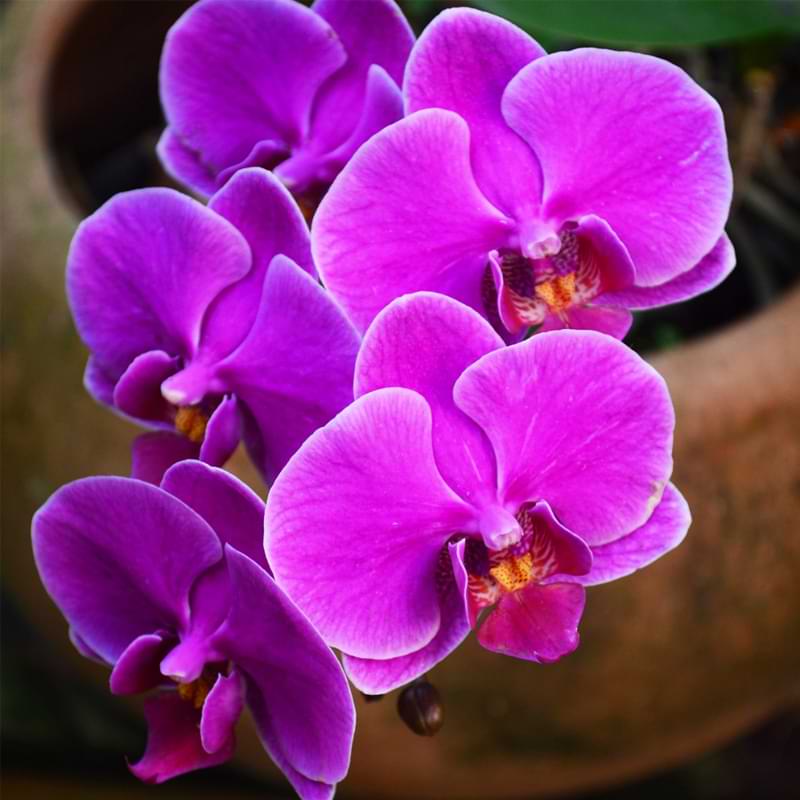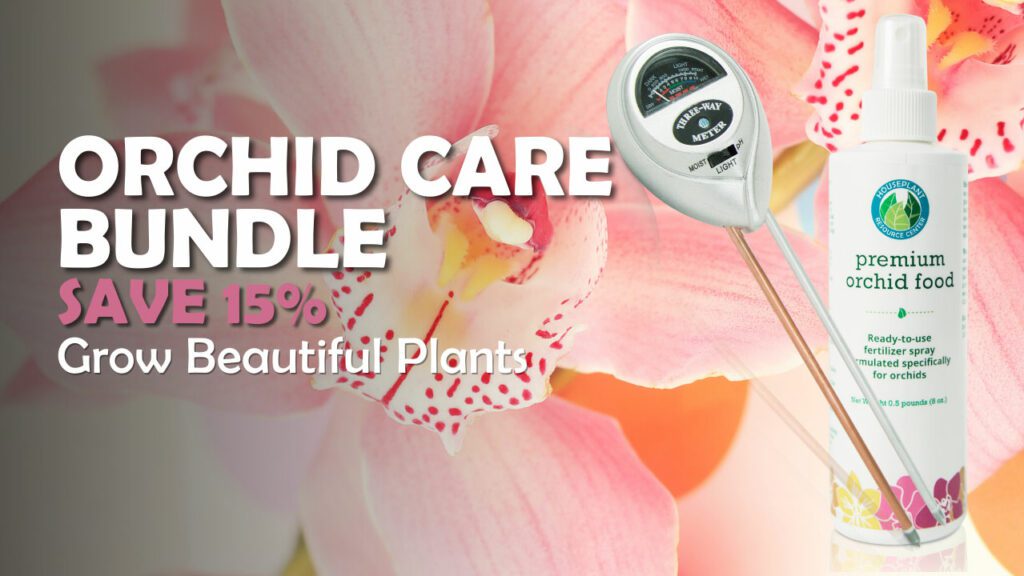Our furry friends are part of our family, and the last thing we want to do is bring something into our home that may harm them. Since cats are notorious for investigating all the plants that get brought into their home, it’s important to only have plants that are pet-safe.
Even though we try to deter leaf nibbles from happening, it is sometimes inevitable. Luckily, the orchid is one plant you can safely bring into your home without worrying about toxicity levels or accidental poisonings of your furry family members.
Are Orchids Dangerous For Cats?
Orchids are not poisonous to cats, however, they can be dangerous if consumed in large quantities. The primary dangers posed by orchids to cats are choking and intestinal blockage. While these risks are not huge or life threatening, it’s still a good idea to contact your veterinarian and follow the instructions they give you.
Orchids are not a dangerous plant for your cat to eat, but if you have used any pesticides, other pest prevention items, or even some fertilizers, those items may be toxic to your pet and may have been accidentally ingested along with the part of the orchid.
Plants That Are Toxic To Cats
There are a variety of plants that are poisonous to cats and can cause them serious health problems if ingested. Some of the most common toxic plants include:
Lilies
Tulips
Daffodils
Azaleas
Rhododendrons
Oleanders
Either of these plants can cause vomiting, diarrhea, lethargy, and even death in cats. Keep in mind, this list is not extensive, and if your cat ingests any plant that he/she shouldn’t have, you should always contact your veterinarian.
If your cat ingests any part of either of the plants listed above, contact your veterinarian immediately. Don’t waste any time getting your cat the cure that could save its life. A good rule of thumb is to contact your vet anytime you think your cat has ingested something they shouldn’t have, especially if you are unsure of whether or not it’s dangerous for them.
Why Are Some Plants Unsafe For Cats
Some plants are unsafe for animal consumption because of certain things that are present in the leaves or flowers, particularly, calcium oxalate and calcium oxalate crystals. This is the case for most toxic plants, although some plants are toxic to animals for other reasons.
Calcium Oxalate Crystals
Calcium oxalate crystals are the most common type of kidney stone. They’re also found in abundance in many plants. While these crystals aren’t poisonous to cats directly, they can cause serious health problems if your cat ingests them.
The reason calcium oxalate can be toxic to your cat is because it is practically insoluble, and can continue to build, creating what’s called calcium oxalate stones.
When calcium oxalate crystals become lodged in a cat’s urinary tract, they can block the flow of urine and cause an infection. In severe cases, the crystals can actually rupture the urinary tract, leading to life-threatening kidney damage.
If you think your cat has eaten a plant that contains calcium oxalate crystals, it’s important to seek veterinary care immediately. With prompt treatment, most cats make a full recovery from calcium oxalate crystal ingestion.
What Part Of A Plant Contains Calcium Oxalate Crystals
Calcium Oxalate can be present in any part of a plant, although the most common place these crystals are found is in the leaves. The amount of these crystals in a plant determines the plant’s toxicity, and some plants may have a higher concentration than others, making it difficult to determine on your own how dangerous a plant actually is for your cat.
Calcium Oxalate can exist in various shapes, and each shape has its own purpose. Mostly, calcium oxalate crystals exist as a defense against being eaten by animals and humans.
Calcium oxalate crystals that are spear shaped will sting the tongue when a human or animal attempts to eat it, though this may not stop a persistent cat from still trying to eat it. Other crystal formations include square, oval, spindle, and more; each shape can be found in different plants or substances
Most of the time, calcium oxalate crystals are found in the juices, leaves, and stems of a plant. Some plants contain calcium oxalate throughout the entire plant. Pothos plants have the highest concentration of crystals in the leaves, as well as philodendron plants and dieffenbachia plants.
Symptoms Of Calcium Oxalate Crystal Poisoning
Once ingested, calcium oxalate crystals can cause swelling and blockages along the esophagus all the way through the intestines and urinary tract.
If your cat eats or comes in contact with any plant that contains calcium oxalate crystals, they may experience the following symptoms:
-Excessive drooling
-Pawing at the mouth
-Difficulty swallowing
-Vomiting
-Diarrhea
-Extreme thirst
-Lethargy
-Collapse
These are some of the more common symptoms to look out for, but if you know your cat has ingested a plant they shouldn’t have, don’t wait to see if symptoms appear. Make sure to identify the plant they have eaten and contact your veterinarian. They may ask you to bring a sample of the plant or the entire plant into the vet office for them to confirm how much your cat may have ingested.
What To Do If Your Cat Has Been Poisoned
If you know or suspect that your cat has eaten a toxic plant, it is important to seek veterinary care immediately. The sooner you can get your cat to a veterinarian, the better their chances are of making a full recovery. Bring a sample of the plant with you if possible so that the veterinarian can properly identify it and treat your cat accordingly.
If you think your cat has been poisoned, it is important to act quickly. The first thing you should do is call your vet or the ASPCA Animal Poison Control Center (APCC) at (888) 426-4435.
Do not make your cat vomit. This can actually do more harm than good, and induced vomiting should only be done by trained veterinary professionals.
This is not a time to sit back and observe your cat for symptoms, unless directed to do so by your veterinarian. As soon as you suspect your cat has eaten a plant they shouldn’t have, call your veterinarian for guidance.
How to Prevent Cats Eating Plants
It is estimated that between 15 and 20 percent of all cats have a chewing compulsion. While most kitties enjoy a good crunch on some grass from time to time, some take things to the extreme and develop a taste for your beloved houseplants.
If your cat has taken a liking to your orchids, it’s important to take measures to prevent them from eating the plants. Orchids are not poisonous to cats, but they can cause gastrointestinal upset if ingested in large quantities, and your furry friend could do some serious damage to your beloved flower.
Here are some tips to keep your feline friend from snacking on your orchids and other houseplants:
Keep Plants Out Of Reach
If your cat can’t get to the plants, they can’t eat them! Place plants on high shelves or in hanging baskets where Fluffy can’t reach them.
If you have cats, it’s important to keep plants out of reach so they can’t nibble on them regardless of if the plant is toxic to them or not. Some plants are poisonous to cats and can make them very sick. It’s not a behavior that should be encouraged even with non-toxic plants.
If you wish to provide your cat with their own plant such as catnip, it may take a bit more effort to discourage your cat from eating the other plants in your home.
Cat Deterrents
Cats don’t like certain smells, so try spraying your plants with lemon juice or placing cinnamon or pepper near the potting area. You can also try commercial products designed to keep cats away from plants.
Spraying your plant with lemon juice will make the leaves taste bad and deter your cat from chewing on them, and the potent smell of cinnamon and pepper should keep even persistent cats away from your plant.
You can also try placing aluminum foil around the base of the plant. Cats don’t like the feel of foil on their paws and will usually avoid it. This method doesn’t work for all cats, though.
You can also place a cage around the plants to ensure your cat can’t reach it. Although not ideal aesthetically, it is sometimes the only deterrent that works when all else fails.
Providing A Distraction
If you catch your cat chewing on any houseplant, give them a firm “no” and redirect their attention to a toy or treat. With patience and consistency, you can train your cat to leave the plants alone, even stubborn ones.
You may even try giving your cat their own houseplant to mutilate as they see fit, but you will have to be consistent with redirecting to “their” plant and reminding them that your plants are off-limits. If you choose to use this method, you may still want to place your plants out of reach while you’re not there to supervise your cat; some kitties may hold a grudge and go after your plants when you’re not there to tell them “no”.

Are Orchids Poisonous To Cats Final Thoughts
In conclusion, while orchids are not poisonous to cats, they can cause gastrointestinal upset if ingested. If you have a cat that is prone to chewing on plants, it is best to keep orchids and any other house plant out of reach. There are some plants that are highly toxic to your furry friends, and it’s always better to err on the side of caution with what your cat may ingest.
If your cat does eat part of your orchid, monitor them closely and contact your veterinarian if you notice any behavior that deviates from their normal behavior. Additionally, keep your cat safe by knowing every type of plant you have in your home, and what their toxicity is to cats (and other animals). An ounce of prevention is worth a pound of cure when it comes to your furry family.
Join Our Orchid Care Facebook Community
In our Facebook group of orchid lovers, we’re dedicated to creating a rich and engaging environment where plant lovers can come together and share tips, tricks, and experiences.
If you’re an orchid lover, come join our Facebook community! We can’t wait to celebrate your successes and help you troubleshoot your care routine.
For continued success, you can explore our other articles or visit our online shop for plant care products that are sure to keep your plants boasting rich green leaves and big, bountiful blooms year-round.



